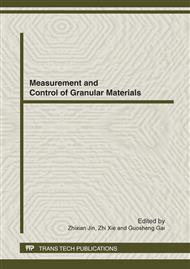p.141
p.146
p.151
p.155
p.160
p.166
p.170
p.175
p.180
Deformation Modes for Assemblies of Frictionless Polydisperse Spheres
Abstract:
The challenge of dealing with cohesive powders during storage, handling and transport are widely known in the process and pharmaceutical industries. Simulations with the discrete element method (DEM) provide further insight into the local microstructure of bulk materials. In this work, the DEM approach is presented to investigate the flow behavior of granular systems subjected to different modes of deformations. When uniaxial compression is applied of frictionless, polydisperse spheres above jamming (transition from fluid-like state to solid-like state), the evolution of coordination number (average number of contacts per particle) and pressure as functions of the volume fraction are, astonishingly, identical to results obtained for purely isotropic compression. Analytical predictions for the evolution of pressure and coordination number under isotropic strain can thus be separated from different deformation modes, as applied in this study. After two different modes of volume-conserving deviatoric shear, the results still compare quite well with results for purely isotropic compression. The difference between the two deviatoric modes and uniaxial deformation is examined with respect to the anisotropic stress response as a function of deviatoric strain.
Info:
Periodical:
Pages:
160-165
Citation:
Online since:
April 2012
Price:
Сopyright:
© 2012 Trans Tech Publications Ltd. All Rights Reserved
Share:
Citation:


